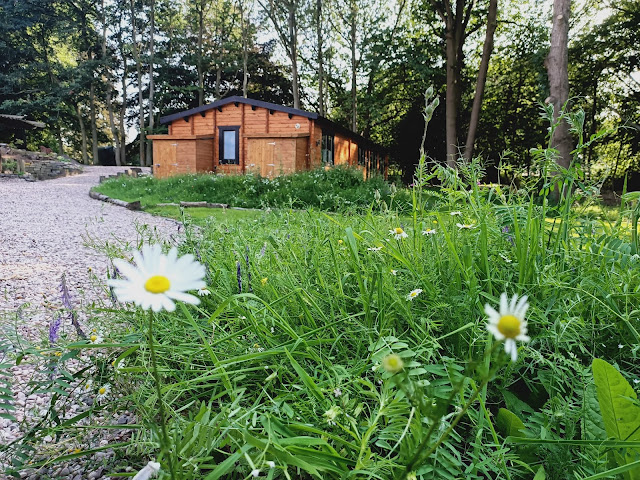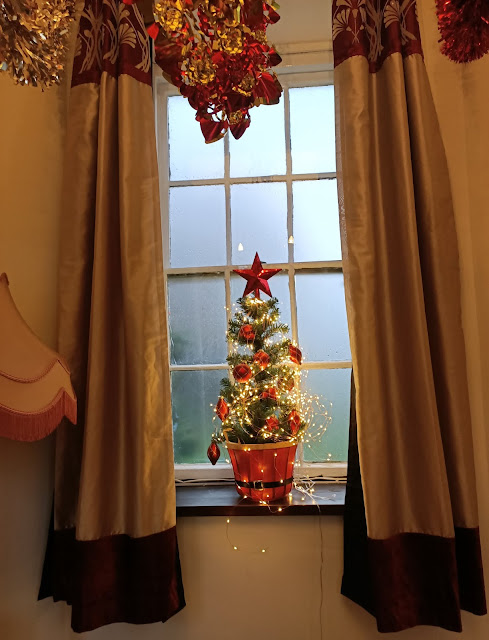Playing Referee Amongst the Wildflowers
There was extraordinary weather over the Staffordshire/South Cheshire border last night. Several hours of heat lightning setting the night sky aglow in dramatic pinks and bruised yellows, followed by a heavy storm that felt like it was directly over our house.
I wish I could say it has eased the temperature a little, but it was 24 degrees before 10 o’clock this morning, much hotter than this Irish-Brit was genetically designed to cope with! Joey Two-Breakfasts is miserable, and is sulking in the kitchen doorway, forlornly hoping that any slight breeze will sooth him.
Funnily
enough, the conservation architect brought up the subject of lightning
management systems this week as part of the ongoing discussions about roof
design. I didn’t know it was a ‘thing’ until now. You learn something new
almost every day when you’re rebuilding a burnt house!
The coping stones have arrived for the final part of the renovations to the dam down in the dingle, that hold the water for the lake. They will cap the gap between the 19th century retaining walls, and hopefully give it a uniform, neat finish. We’d intended to do the work last year, but understandably, the task got delayed when the fire happened. It will be very satisfying to tick everything off on the repairs, and let the area settle down again.
Apart from keeping on top of watering, during this sweltering August heat, the main task has been refereeing growth between plants in the newly planted wildflower area. Willow herbs were quickest to colonize the disturbed ground around the visitors’ hub. There are nine willow herb native to the UK, and we have at least three in Betley Court Gardens. They’re not bad plants in themselves, in fact in bygone times they were used as a leaf tea due to their tannin content, until black Indian tea became so popular. As I want to encourage other species like bladder campion, poppies and ox-eye daisies, I’m selectively hand-pulling willow herbs in this area. It’s a delicate activity. Some of the flowers have gone to seed already, and their pods are primed to burst at the slightest disturbance and spread their downy air-born seeds on the wind.
I’ve hand-pulled nettles too, where they are close to path edges, and am covered in nettle rash up to my elbows for my efforts! These are mean plants, and sting me through the thick denim of my jeans. However, they have a place in the scheme of thing too. There are five native butterfly species that use nettles exclusively during part of their life cycle. We let nettles get on with their lives, in out of the way patches, and hopefully, it’ll encourage the local butterfly population.
There was one plant I couldn’t quite identify this week, so I placed a picture on an online gardening forum to see what I could find out.
The flower was instantly recognizable as a member of the Solanaceae plant family, which includes potatoes, aubergines and tomatoes, but also deadly nightshade. Deadly nightshade is commonly known as belladonna (fair lady) as ladies once used the juice of the berries to induce a fashionable, but artificial pallor, and to dilate the eyes. Cethelen, from the forum and I’m guessing from the USA, got back to me and confirmed the plant is a black nightshade (Solanum nigrum). When ripe the berries are eaten over there (although Cethelen point out they are ‘stomach ache poisonous’ when green). Specially bred cultivars are sold under the imaginative names ‘garden huckberry’ or ‘Wonderberry’ – presumably bred to reduce harmful toxins and bigger berries! Fascinating, but I don’t think I’ll be growing them to eat any time soon!
I’m enjoying the range of wildflowers in bloom at the moment. Some are becoming a bit floppy under the weight of their own flowers, so Nigel and I have bought hand forged plant supports from friend of Betley Court Gardens, the blacksmith Charis Jones to help prop them up. They’ll look much better than the sticks I’ve shoved in the soil for support.
The next job for the wildflower area will occur in September or October. We’ll need to scythe, or brush-cut the top growth down to about 10cm (4”), and most importantly LEAVE the cut flowerheads on the ground for a week or so to dry out. This allows seeds to fall onto the ground for next year’s flowers.
We won’t be making that mistake here, and if you should spot Nigel next month, stripped to the waist, in the style of Ross Poldark, scythe in hand, you’ll know what he’s up to!
All best wishes
Ladybird Su














Comments
Post a Comment